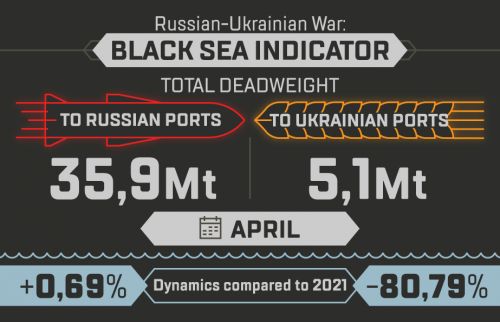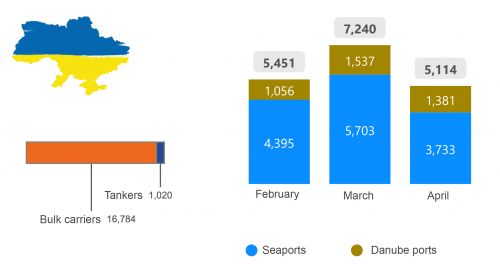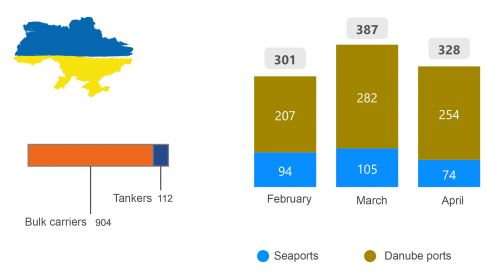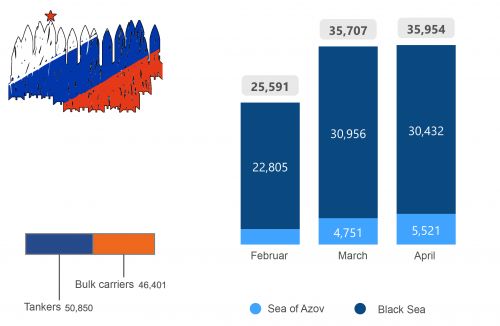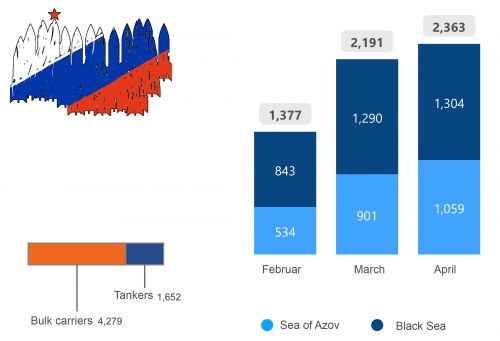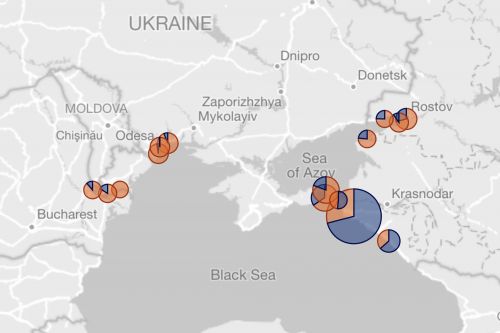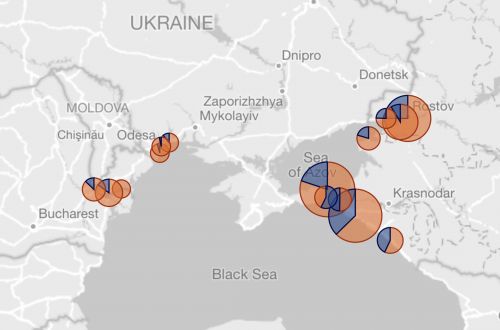Opportunities for exports of Ukrainian goods are limited because of the blocking of freedom of navigation in the Black Sea by Russia, the occupation of Ukraine’s ports on the Sea of Azov, and numerous obstacles to the operation of the Black Sea "grain corridor." Meanwhile, Russian seaports on the Black Sea and the Sea of Azov are receiving vessels without restrictions, sometimes increasing cargo transshipment and generating budget revenues for Russia.
The Black Sea Indicator project by the CFTS and Maritime Logistics monitors the total deadweight tonnage and the number of vessels processed by seaports in Ukraine and the Black Sea/Sea of Azov region of Russia. A comparison of the latest indicators and the pre-war 2021 indicators is also provided to help understand the unfair disproportion caused by the blockade of Ukrainian ports.
Dynamics of freight transshipment in Ukrainian and Russian ports in April 2023
The total deadweight tonnage of the ships that entered the Pivdennyi, Chornomorsk, and Odesa seaports, as well as those that entered Ukraine’s ports on the River Danube, was 5.1 million tons in April 2023. In this analysis, we compare this indicator with the average monthly indicator for Ukrainian seaports in 2021, on the eve of the great war. The April 2023 indicator is almost 81% lower than the monthly average in 2021.
Meanwhile, ships with a total deadweight tonnage of 35.9 million tons entered Russia’s seaports on the Sea of Azov and the Black Sea last month. This is 0.7% more than the average figure for these Russian seaports in 2021.
Distribution of total deadweight tonnage of ships entering Ukrainian ports
Regarding the Ukrainian ports that can currently operate, Danube ports received ships with a total deadweight tonnage of 1.4 million tons in April while the ports of Greater Odesa received ships with a total deadweight tonnage of 3.7 million tons.
Ukrainian seaports received tankers with a total deadweight tonnage of 1.02 million tons in the first four months of 2023. Dry cargo ships accounted for the lion's share (16.8 million tons) of the total deadweight tonnage of the ships they received.
*Breakdown of total deadweight tonnage (thousand tons) of vessels entering Ukrainian ports by ship type and port category
Distribution of the number of ship calls at Ukrainian seaports
The number of ship calls at all the Ukrainian seaports that are open or partially open totaled only 328 in April. Given the low tonnage of the ships that can operate on the River Danube and the constant obstruction of the "grain corridor" by Russian representatives, we can see that the number of ship calls at Danube ports (254) was greater than the number of ship calls at "high-water" ports (74).
The indicator for April is higher than the indicators for January and February, when the numbers of ship calls at these ports were 246 and 301, respectively, but lower than the indicator for March (387).
In the first four months of the year, 904 port calls by dry cargo vessels and 112 port calls by tankers were recorded.
*Breakdown of the number of ship calls at Ukrainian ports by ship type and port category
Distribution of total deadweight tonnage of vessels calling at Russian ports
As the analysis shows, the situation in Russia’s Azov and Black Sea ports is better by all parameters. Russian seaports on the Sea of Azov alone processed ships with a total deadweight tonnage of 5.5 million tons in April, which is significantly more than the total deadweight tonnage of the ships processed by the ports of Greater Odesa, which operate through the Black Sea "grain corridor." Russia’s Black Sea ports received ships with a total deadweight tonnage of 30.4 million tons, which is more than the total deadweight tonnage of all the ships that have called at Ukrainian seaports since the beginning of this year.
Tankers with a total deadweight tonnage of 50.8 million tons and dry cargo ships with a total deadweight tonnage of 46.4 million tons entered Russian seaports in the period of January-April. These two indicators are approximately equal, which is not surprising because Russia actively exports crude oil despite sanctions.
*Breakdown of total deadweight tonnage (thousand tons) of ships calling at Russian ports by vessel type and port category
Distribution of the number of ship calls at Russian ports
If the deadweight tonnage of dry cargo ships and tankers is divided approximately equally, then the number of dry cargo ships (4,279) that called at Russian ports is more than twice the number of tankers (1,652). Unfortunately, these indicators currently seem unattainable for Ukrainian seaports.
The same applies to the distribution of ship calls by sea. In April, 1,059 ship calls were made at the Russian seaports on the Sea of Azov. This is three times more than the number of ship calls at all the ports currently operating in Ukraine. Ships called at Russian seaports on the Black Sea 1,059 times last month.
*Breakdown of the number of ship calls at Russian ports by ship type and port category
Distribution of total deadweight tonnage of ships entering ports
Among Ukrainian ports, the Chornomorsk seaport processed ships with the largest deadweight tonnage (1.35 million tons) in April, followed by the Odesa seaport (1.3 million tons) and the Pivdennyi seaport (1.7 million tons). The leader among the ports on River Danube was the Izmail port (0.77 million tons).
The Novorossiysk seaport is the leader in the region among Russian seaports. This seaport received ships with a total deadweight tonnage of 17.8 million tons in April 2023, which is over three times the combined deadweight tonnage of the ships received by all Ukrainian ports during this period. The port of Kavkaz received ships with a total deadweight tonnage of 5 million tons and the port of Taman received ships with a total deadweight tonnage of 4.7 million tons. In the Sea of Azov, the Port of Rostov-on-Don received ships with the largest total deadweight tonnage (2.8 million tons).
*Distribution of total deadweight tonnage of ships entering ports
Distribution of the number of ship calls at ports
In terms of the number of ship calls at ports in April, the Izmail seaport led the way among Ukrainian seaports with 136, followed by the Reni seaport with 93.
Among the ports of Greater Odesa, the Chornomorsk seaport received the largest number of ships in April (28), followed by the Odesa seaport (26), and the Pivdennyi seaport (20).
Among Russian seaports, the port of Kavkaz had the largest number of ship calls (584), followed by the Port of Rostov-on-Don (538) and the Novorossiysk seaport (504).
*Distribution of the number of ship calls at ports


